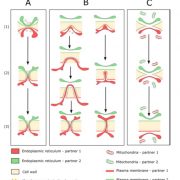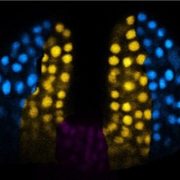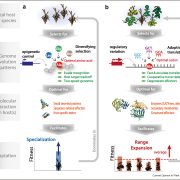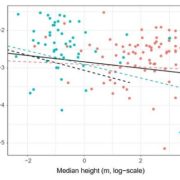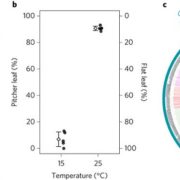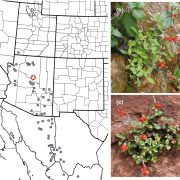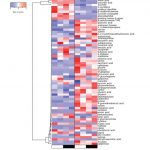Land plants recruited an ancestral bHLH for tip-growing surface cell development ($) (New Phytol)
 Land plants (embryophytes) evolved from freshwater charophycean algae over 450 million years ago. The transition from aquatic to terrestrial environments likely required the evolution and expansion of genetic programs controlling three dimensional growth and the formation of tip-growing surface cells (rhizoids/root hairs) from the plant body. Bonnot et al. investigated the function and evolutionary history of basic helix-loop-helix (bHLH) transcription factors implicated in the development of tip-growing surface cells in land plants and their algal predecessors. Phylogenetic analyses first established that the multicellular charophytes Chara braunii and Coleochate nitellarum encode homologs belonging to the bHLH VIII gene family that contains the tip-growth (root hair) controlling members RHD6 (ROOT HAIR DEFECTIVE6) and RSL (RHD6-LIKE). Cross-complementation experiments utilizing the root hair defective Arabidopsis thaliana (angiosperm) double mutant rhd6/rsl1 and the rhizoid-deficient Marchantia polymorpha (liverwort) Mprsl1 mutant showed that ectopic expression of charophyte bHLHVIII homologs failed to rescue the root hair/rhizoid-defective phenotypes of mutants in either lineage, whereas MpRSL expression reliably rescued Arabidopsis rhd6/rsl1 and Mprsl. To identify potential roles for charophyte bHLHVIII genes in development, the authors performed expression analyses in distinct tissues of the model charophyte Chara braunii. Intriguingly, CbbHLHVIII was minimally expressed in C. braunii rhizoids and was most highly abundant in gametangia (sexual reproduction) and thalli (body). More detailed analysis further revealed the preferential expression of CbbHLHVIII in young branchletes with gametangia and younger tissues of the thallus (newly developed nodes) containing apical cells. Collectively, these data clarify the evolutionary history of bHLHVIII transcription factors that underwent neofunctionalization in land plants to control the development of rhizoids and root hairs. (Summary by Phil Carella) New Phytol. 10.1111/nph.15829
Land plants (embryophytes) evolved from freshwater charophycean algae over 450 million years ago. The transition from aquatic to terrestrial environments likely required the evolution and expansion of genetic programs controlling three dimensional growth and the formation of tip-growing surface cells (rhizoids/root hairs) from the plant body. Bonnot et al. investigated the function and evolutionary history of basic helix-loop-helix (bHLH) transcription factors implicated in the development of tip-growing surface cells in land plants and their algal predecessors. Phylogenetic analyses first established that the multicellular charophytes Chara braunii and Coleochate nitellarum encode homologs belonging to the bHLH VIII gene family that contains the tip-growth (root hair) controlling members RHD6 (ROOT HAIR DEFECTIVE6) and RSL (RHD6-LIKE). Cross-complementation experiments utilizing the root hair defective Arabidopsis thaliana (angiosperm) double mutant rhd6/rsl1 and the rhizoid-deficient Marchantia polymorpha (liverwort) Mprsl1 mutant showed that ectopic expression of charophyte bHLHVIII homologs failed to rescue the root hair/rhizoid-defective phenotypes of mutants in either lineage, whereas MpRSL expression reliably rescued Arabidopsis rhd6/rsl1 and Mprsl. To identify potential roles for charophyte bHLHVIII genes in development, the authors performed expression analyses in distinct tissues of the model charophyte Chara braunii. Intriguingly, CbbHLHVIII was minimally expressed in C. braunii rhizoids and was most highly abundant in gametangia (sexual reproduction) and thalli (body). More detailed analysis further revealed the preferential expression of CbbHLHVIII in young branchletes with gametangia and younger tissues of the thallus (newly developed nodes) containing apical cells. Collectively, these data clarify the evolutionary history of bHLHVIII transcription factors that underwent neofunctionalization in land plants to control the development of rhizoids and root hairs. (Summary by Phil Carella) New Phytol. 10.1111/nph.15829


